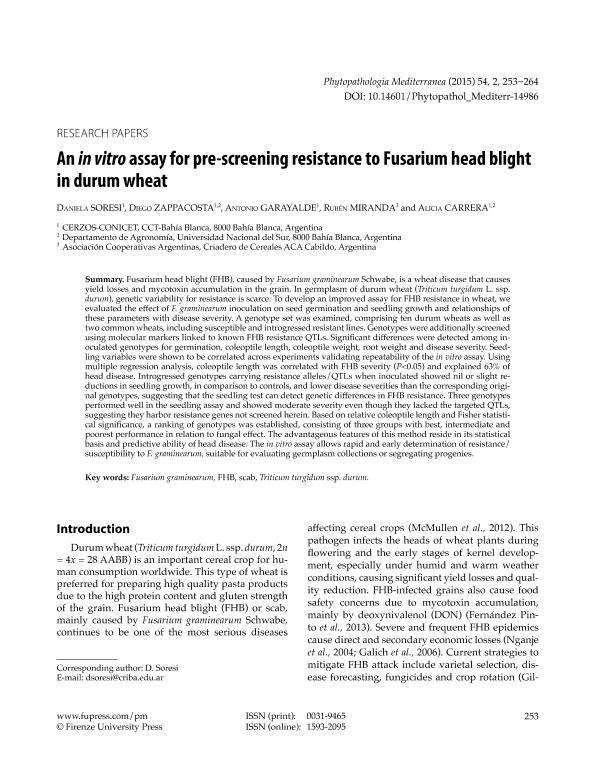Mostrar el registro sencillo del ítem
dc.contributor.author
Soresi, Daniela Soledad

dc.contributor.author
Zappacosta, Diego Carlos

dc.contributor.author
Garayalde, Antonio Francisco

dc.contributor.author
Miranda, Rubén
dc.contributor.author
Carrera, Alicia Delia

dc.date.available
2023-10-10T15:47:35Z
dc.date.issued
2015-07
dc.identifier.citation
Soresi, Daniela Soledad; Zappacosta, Diego Carlos; Garayalde, Antonio Francisco; Miranda, Rubén; Carrera, Alicia Delia; An in vitro assay for pre-screening resistance to Fusarium head blight in durum wheat; Mediterranean Phytopathological Union; Phytopathologia Mediterranea; 54; 2; 7-2015; 253-264
dc.identifier.issn
0031-9465
dc.identifier.uri
http://hdl.handle.net/11336/214710
dc.description.abstract
Fusarium head blight (FHB), caused by Fusarium graminearum Schwabe, is a wheat disease that causes yield losses and mycotoxin accumulation in the grain. In germplasm of durum wheat (Triticum turgidum L. ssp. durum), genetic variability for resistance is scarce. To develop an improved assay for FHB resistance in wheat, we evaluated the effect of F. graminearum inoculation on seed germination and seedling growth and relationships of these parameters with disease severity. A genotype set was examined, comprising ten durum wheats as well as two common wheats, including susceptible and introgressed resistant lines. Genotypes were additionally screened using molecular markers linked to known FHB resistance QTLs. Significant differences were detected among inoculated genotypes for germination, coleoptile length, coleoptile weight, root weight and disease severity. Seedling variables were shown to be correlated across experiments validating repeatability of the in vitro assay. Using multiple regression analysis, coleoptile length was correlated with FHB severity (P<0.05) and explained 63% of head disease. Introgressed genotypes carrying resistance alleles/QTLs when inoculated showed nil or slight reductions in seedling growth, in comparison to controls, and lower disease severities than the corresponding original genotypes, suggesting that the seedling test can detect genetic differences in FHB resistance. Three genotypes performed well in the seedling assay and showed moderate severity even though they lacked the targeted QTLs, suggesting they harbor resistance genes not screened herein. Based on relative coleoptile length and Fisher statistical significance, a ranking of genotypes was established, consisting of three groups with best, intermediate and poorest performance in relation to fungal effect. The advantageous features of this method reside in its statistical basis and predictive ability of head disease. The in vitro assay allows rapid and early determination of resistance/susceptibility to F. graminearum, suitable for evaluating germplasm collections or segregating progenies.
dc.format
application/pdf
dc.language.iso
eng
dc.publisher
Mediterranean Phytopathological Union

dc.rights
info:eu-repo/semantics/openAccess
dc.rights.uri
https://creativecommons.org/licenses/by-nc-sa/2.5/ar/
dc.subject
FHB
dc.subject
FUSARIUM GRAMINEARUM
dc.subject
SCAB
dc.subject
TRITICUM TURGIDUM SSP. DURUM
dc.subject.classification
Agricultura

dc.subject.classification
Agricultura, Silvicultura y Pesca

dc.subject.classification
CIENCIAS AGRÍCOLAS

dc.title
An in vitro assay for pre-screening resistance to Fusarium head blight in durum wheat
dc.type
info:eu-repo/semantics/article
dc.type
info:ar-repo/semantics/artículo
dc.type
info:eu-repo/semantics/publishedVersion
dc.date.updated
2023-10-10T10:10:18Z
dc.journal.volume
54
dc.journal.number
2
dc.journal.pagination
253-264
dc.journal.pais
Italia

dc.description.fil
Fil: Soresi, Daniela Soledad. Consejo Nacional de Investigaciones Científicas y Técnicas. Centro Científico Tecnológico Conicet - Bahía Blanca. Centro de Recursos Naturales Renovables de la Zona Semiárida. Universidad Nacional del Sur. Centro de Recursos Naturales Renovables de la Zona Semiárida; Argentina
dc.description.fil
Fil: Zappacosta, Diego Carlos. Consejo Nacional de Investigaciones Científicas y Técnicas. Centro Científico Tecnológico Conicet - Bahía Blanca. Centro de Recursos Naturales Renovables de la Zona Semiárida. Universidad Nacional del Sur. Centro de Recursos Naturales Renovables de la Zona Semiárida; Argentina
dc.description.fil
Fil: Garayalde, Antonio Francisco. Consejo Nacional de Investigaciones Científicas y Técnicas. Centro Científico Tecnológico Conicet - Bahía Blanca. Centro de Recursos Naturales Renovables de la Zona Semiárida. Universidad Nacional del Sur. Centro de Recursos Naturales Renovables de la Zona Semiárida; Argentina
dc.description.fil
Fil: Miranda, Rubén. Universidad Nacional del Sur. Departamento de Matemática; Argentina
dc.description.fil
Fil: Carrera, Alicia Delia. Consejo Nacional de Investigaciones Científicas y Técnicas. Centro Científico Tecnológico Conicet - Bahía Blanca. Centro de Recursos Naturales Renovables de la Zona Semiárida. Universidad Nacional del Sur. Centro de Recursos Naturales Renovables de la Zona Semiárida; Argentina
dc.journal.title
Phytopathologia Mediterranea

dc.relation.alternativeid
info:eu-repo/semantics/altIdentifier/url/https://oajournals.fupress.net/index.php/pm/article/view/5617
dc.relation.alternativeid
info:eu-repo/semantics/altIdentifier/doi/http://dx.doi.org/10.14601/Phytopathol_Mediterr-14986
Archivos asociados
